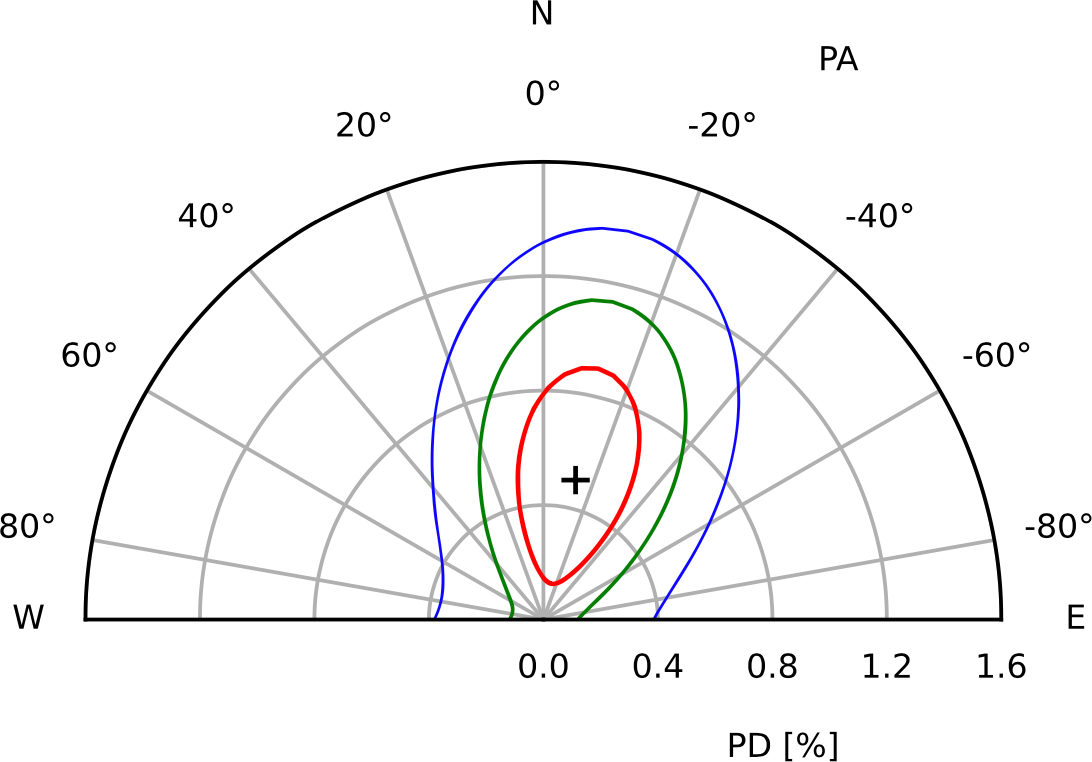NICER / ISS Science Nugget
for July 11, 2024
Black-hole polarization, trending
A blazingly bright black-hole binary (BHB) graced the Milky Way in the Fall of 2023: Swift J1727.8-1613 was initially discovered in late August and quickly became the second-brightest X-ray source in the sky. The character of its emissions across the electromagnetic spectrum, and how they evolved with time, were fully consistent with the behavior of other known binary systems in which a
black hole draws matter from a low-mass companion star, channeling it into an accretion disk. The overall brightness, together with spectral and timing properties, trends with the rate of mass transfer, initially increasing and then falling off over the course of an outburst that typically lasts a few months. A progression of accretion "states" is tagged to reflect whether high-energy
("hard") or low-energy ("soft") X-ray emission dominates the spectrum: BHBs transition from the hard state, through hard-intermediate and soft-intermediate states (HIMS and SIMS) as the accretion disk fills in, to the soft state
dominated by thermal emission from the innermost parts of the hot disk, and they finally cycle back to the hard state as mass transfer ceases and the disk evaporates. In the case of Swift J1727, our ability to track these successive transitions was hampered: during the winter months, Swift J1727 was obscured
from our view by the Sun crossing the plane of the Milky Way on its annual circular journey against the backdrop of stars. Nevertheless, NICER and other
missions carried out observations that revealed previously unseen
features of BHB X-ray emission.
A pair of peer-reviewed papers recently published in The Astrophysical Journal and its companion Letters describes measurements of X-ray polarization, made with NASA's IXPE telescope, spanning the HIMS and soft state of Swift J1727, showing that in addition to the well-known spectral and timing trends across states, some aspects of X-ray polarization also evolve. Polarization measurements with IXPE are more robust when simultaneous energy-spectrum measurements are available from another telescope, so coordinated NICER observations were performed in support of the long-term IXPE study.
A. Ingram (Newcastle Univ., UK) and collaborators report the degree of linear polarization (as a percentage of total X-ray emission) and its orientation on the sky during September and October 2023 . They find that the orientation remains roughly constant as the system sweeps through the HIMS, while the degree of polarization falls steadily. Ingram et al. also examine short-timescale intensity variations of Swift J1727 seen by NICER, in different photon-energy bands, and compare them with similar measurements from other BHBs; they find that the timing behavior of Swift J1727 does not conform with that seen in most other systems, but instead suggests that J1727 belongs to an "outlier" sub-population of accreting binaries, for reasons not fully understood but that may be related to the angle from which we view its orbital plane. J. Svoboda (Astron. Inst. of the Czech Academy of Sci., Czech Rep.) and collaborators continued IXPE measurements in February 2024, after Swift J1727 reemerged from behind the Sun, again with supporting NICER observations. They found J1727 to be fully in its soft state, with polarization now only a small fraction (< 1 %) of the total X-ray emission, continuing the decreasing trend seen in the HIMS by Ingram et al., but with the residual linear polarization still maintaining orientation consistent with the previous measurements. Both results uphold expectations that the polarized emission originates principally in a region known as the "corona," a superheated plasma with still-uncertain localization and geometry, but call into question some earlier interpretations of the causes for short-timescale variability. A new picture of the physical configuration of accretion structures in BHBs may soon be emerging as a result of these and similar polarization and timing-spectroscopy measurements.


Left: Polarization and timing evolution of the black-hole binary Swift J1727.8-1613 across three accretion states Ð hard, hard-intermediate, and soft-intermediate Ð as quantified by a measure known as "hue" (derived from ratios of total X-ray intensity and how it is distributed across photon energies). The top and middle panels show IXPE measurements of polarization degree (PD) and position angle on the sky (PA, where 0 deg is North) of the linearly polarized part of the emission. The bottom panel shows NICER measurements (symbols in legend box) of millisecond-scale time intervals between leading high-energy brightness variations and related, lagging low-energy variability. The brown shaded area indicates the average behavior of 8 other black-hole binaries, as well as single measurements from two outlier systems (turquoise and pink pentagon symbols), all measured with NICER. Swift J1727's timing lags are in line with the outliers rather than the more common average behavior. (Credit: Ingram et al. 2024)
Right: Polarization degree (radial axis) and position angle (azimuthal axis) of Swift J1727 in its soft state, measured with IXPE in February 2024 with support from concurrently-acquired NICER energy spectra. The PD of less than 1% is substantially less than the Fall 2023 measurements seen in Figure 1, while the PA remains consistent with a generally northerly orientation. (Credit: Svoboda et al. 2024)
<< Previous
Main Index
Next >>